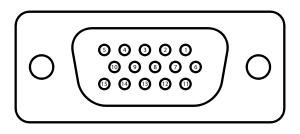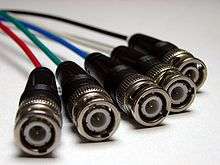VGA connector
|
A female DE-15 output in a laptop computer. | |||
| Type | Computer analog video connector | ||
|---|---|---|---|
| Production history | |||
| Designer | IBM based on D-subminiature | ||
| Designed | 1987 | ||
| Produced | 1987 to present | ||
| Superseded | CRT | ||
| Superseded by | DVI (1999) | ||
| General specifications | |||
| Hot pluggable | Depends | ||
| Video signal | RGB video signal plus option H and V sync | ||
| Pins | 15 | ||
| Connector | DE-15 | ||
| Data | |||
| Data signal | I²C data channel for DDC information | ||
| Pin out | |||
 | |||
| A female DE15 socket (videocard side). | |||
| Pin 1 | RED | Red video | |
| Pin 2 | GREEN | Green video | |
| Pin 3 | BLUE | Blue video | |
| Pin 4 | ID2/RES | formerly Monitor ID bit 2, reserved since E-DDC | |
| Pin 5 | GND | Ground (HSync) | |
| Pin 6 | RED_RTN | Red return | |
| Pin 7 | GREEN_RTN | Green return | |
| Pin 8 | BLUE_RTN | Blue return | |
| Pin 9 | KEY/PWR | formerly key, now +5V DC, powers EDID EEPROM chip on some monitors | |
| Pin 10 | GND | Ground (VSync, DDC) | |
| Pin 11 | ID0/RES | formerly Monitor ID bit 0, reserved since E-DDC | |
| Pin 12 | ID1/SDA | formerly Monitor ID bit 1, I²C data since DDC2 | |
| Pin 13 | HSync | Horizontal sync | |
| Pin 14 | VSync | Vertical sync | |
| Pin 15 | ID3/SCL | formerly Monitor ID bit 3, I²C clock since DDC2 | |
| The image and table detail the 15-pin VESA DDC2/E-DDC connector; the diagram’s pin numbering is that of a female connector functioning as the graphics adapter output. In the male connector, this pin numbering corresponds with the mirror image of the cable’s wire-and-solder side. | |||
A Video Graphics Array (VGA) connector is a three-row 15-pin DE-15 connector. The 15-pin VGA connector was provided on many video cards, computer monitors, laptop computers, projectors, and high definition television sets. On laptop computers or other small devices, a mini-VGA port was sometimes used in place of the full-sized VGA connector.
DE-15 has been conventionally referred to ambiguously as D-sub 15, incorrectly as DB-15 and often as HD-15 (High Density, to distinguish it from the older and less flexible DE-9 connector used on old VGA cards, which has the same E shell size but only two rows of pins). The video connector is an "E" size D-sub connector, with 15 pins in three rows, which is the high-density connector version (DB15HD).
VGA connectors and cables carry analog component RGBHV (red, green, blue, horizontal sync, vertical sync) video signals, and VESA Display Data Channel (VESA DDC) data. In the original version of DE-15 pinout, one pin was keyed by plugging the female connector hole; this prevented non-VGA 15 pin cables from being plugged into a VGA socket. Four pins carried Monitor ID bits which were rarely used; VESA DDC redefined some of these pins and replaced the key pin with +5 V DC power supply. Devices that comply with the DDC host system standard provide 5V ±5% and supply a minimum of 300mA to a maximum of 1A.
The VGA interface is not engineered to be hotpluggable (so that the user can connect or disconnect the output device while the host is running), although in practice this can be done and usually does not cause damage to the hardware or other problems. However, nothing in the design ensures that the ground pins form the first make or the last break in the connection, so hotplugging may introduce surges in signal lines which may or may not be adequately protected against damage. Also, depending on the hardware and software, monitor detection is sometimes unreliable when hotplugging a VGA connection.
Although many devices still include VGA connectors, and VGA generally coexisted with the DVI standard, VGA and DVI are both being rapidly phased out in favor of the newer and more compact HDMI and DisplayPort interface connectors.
Cable quality

The same VGA cable can be used with a variety of supported VGA resolutions, ranging from 640×350px @70 Hz (24 MHz of signal bandwidth) to 1280×1024px (SXGA) @85 Hz (160 MHz) and up to 2048×1536px (QXGA) @85 Hz (388 MHz). There are no standards defining the quality required for each resolution but higher-quality cables typically contain coaxial wiring and insulation which make them thicker. Shorter VGA cables are less likely to introduce significant signal degradation. A good-quality cable should not suffer from signal crosstalk, whereby signals in one wire induce unwanted currents in adjacent wires, or ghosting. Ghosting occurs when impedance mismatches cause signals to be reflected. However, ghosting with long cables may be caused by equipment with incorrect signal termination or by passive cable splitters rather than the cables themselves.

Some high-end monitors and video cards featured 5 separate BNC connectors for RGBHV signal, allowing highest quality connection using five 75 ohm coaxial cables. Within a 15-pin connector, the red, green, and blue signals (pins 1, 2, 3) cannot be shielded from each other, so crosstalk is possible within the 15-pin interconnect. BNC prevents crosstalk by maintaining full coaxial shielding through the circular connectors, but the connectors are very large and bulky. The requirement to press and turn the plug shell to disconnect requires access space around each connector to allow grasping of each BNC plug shell. Supplementary signals such as DDC are typically not supported with BNC.
Adapters
There are DVI to VGA adapters and cables. They do not carry audio channels, thus separate path for audio should be used, if needed.
To connect VGA to interfaces with different signaling and vice versa converters may be used. Most of them need an external power source to operate and are inherently lossy.
VGA to SCART converter that passes through color information is possible, because VGA — SCART RGB signals are electrically compatible, except for synchronization. Modern graphics adapters are able to widely modify their signal in software, including refresh rate, sync length, polarity and number of blank lines. Particular issues include whether or not interlacing is supported as well as if the resolution can be set to 720×576 in PAL countries. Under these strict conditions, a simple circuit to combine the VGA separate synchronization signals into SCART composite sync may suffice.[1][2]
See also
- Component video
- Digital Visual Interface (DVI)
- Display Data Channel (DDC)
- Extended display identification data (EDID)
- HDMI
- List of video connectors
- Super Video Graphics Array (SVGA)
- Video Electronics Standards Association (VESA)
- VGA extender
References
- ↑ "The Nexus: Projects - VGA to SCART Converter". Nexusuk.org. 2013-06-26. Retrieved 2013-10-21.
- ↑ "VGA to TV converter page". Epanorama.net. Retrieved 2013-10-21.
